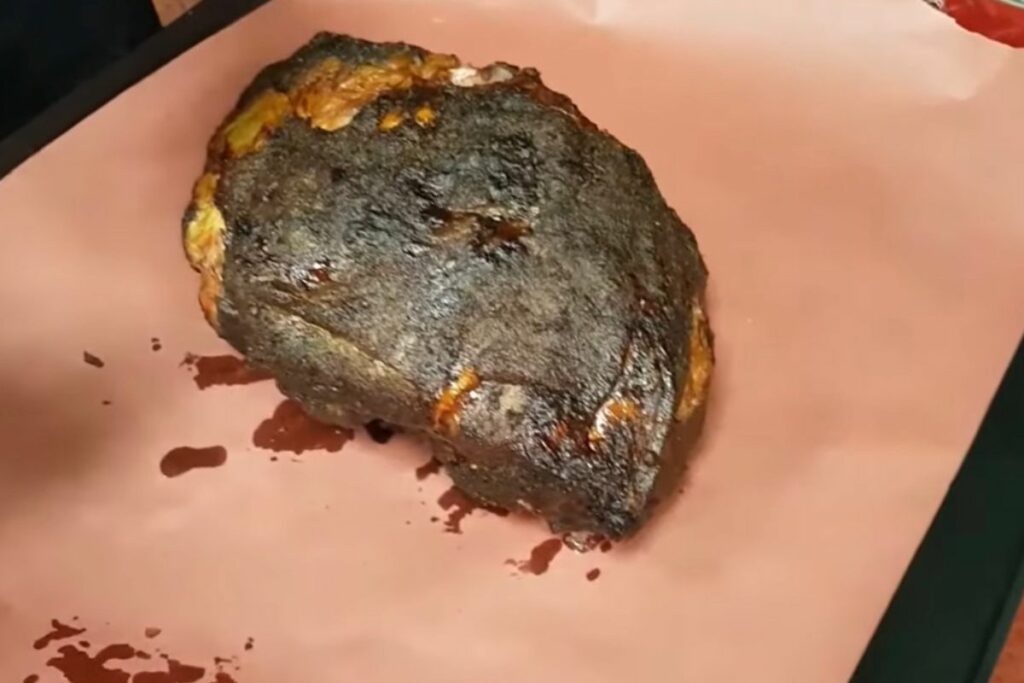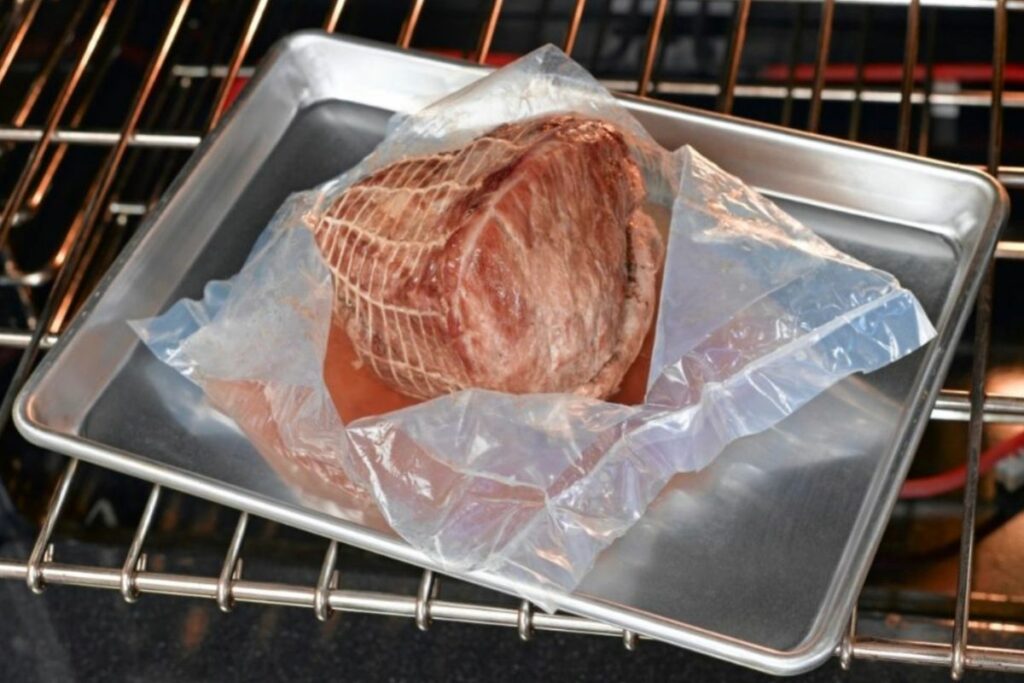Pork butt, or a Boston butt is one of the most delicious cuts of meat that you can cook in your smoker for a beautiful, succulent flavor every time.
As the pork butt is rather fatty, and layers of fat sweep through the meat, it is tender, flavorful and soft when cooked to perfection.

The only issue is that if you don’t follow the steps, and you don’t wrap your pork butt, then it’s just not going to be the same. Pitmasters will swear to you that wrapping a pork butt makes the difference between having a perfectly smoked pork, and a subpar cut of meat.
The only thing is, you have to wrap the pork butt at the right time, but many smoking enthusiasts just aren’t sure when that optimal moment is. This is where our guide comes in handy, so when do you wrap a pork butt, what is it and how do you prepare it? Let’s find out!
What Is A Pork Butt?
The pork butt is the most commonly used cut of meat to create pulled pork dishes. Let’s be clear, it’s not the pig’s butt!
Although it sounds like this hunk of meat is derived from the pig’s sweet cheeks, a pork butt actually comes from around the pig’s shoulder. However, it is not the same as a ‘pork shoulder’. A pork shoulder is actually a little further down the front legs. Confused yet?
If you’re not already confused with all of the names, then the term Boston butt is also used to refer to a pork butt!
This term actually dates back before colonial times, where butchers would store these fatty, less popular cuts of meat into barrels that they referred to as ‘butts’ and so, the pork butt was born! As this tradition began in New England, the term Boston butt was used when it was exported to other countries.
As mentioned above, the pork butt actually comes from the shoulder of the pig, but it is higher up on the foreleg than the pork shoulder, so the two are not the same.
Because of where the pork butt comes from, this cut of meat tends to be rather tough and fatty, so you will need to cook this cut with low, slow cooking methods to get the perfect flavor and tenderness that you so desire.
This is why pork butt is often used for authentic barbecue recipes, as when cooked at very low temperatures for a long time, the connective tissues in the meat have time to break down, which allows the fat to melt into the surrounding meat and infuse it with softness and flavor. The result is tender, melt in your mouth pork.
Why Do We Wrap Pork Butt?
Some BBQ lovers will say that you don’t need to wrap the pork butt, whereas others will say you have to! It’s the topic of hot debate in the barbecue world! That being said, we’re on the side of wrapping the butt as it makes such a huge difference.
This is largely because the pork butt is full of fat, and wrapping it in foil will help to seal in all of the juices and make it soft, tender and juicy for the best flavor.
By wrapping the pork butt, you will be keeping in all of the rendered fat, instead of it dripping all over the coals of your barbecue or filtering off into the grill. So, when you seal and wrap the pork, you are sealing in all of that tasty fat that brings the flavor to the meat.
In addition to making the meat much more flavorful and tasty, by wrapping the pork butt, you are also ensuring that it remains moist and does not dry out. For instance, if you cook the pork butt entirely without wrapping it, it could become dry and tough, and you won’t have that soft, tender, falling apart pulled pork that you want.
This is definitely not what you want to happen, especially when you consider how long it takes to cook pork butt. You don’t want to slave over your pit all day just for the end result to be dry and lacklustre.
Another reason we wrap the pork butt is to seal in the smoky flavor. If you’ve been smoking your pork all afternoon, by the time you wrap it, you can ensure that those smoked scents and flavor are infused in the meat, and the wrapped foil will keep it there.
The foil is also super insulating, so wrapping the meat can also keep the cooking time down, as it will cook faster once wrapped up in the aluminum foil.
Using foil to wrap your meat when barbecuing is what we call the ‘Texas crutch’. The Texas crutch is used by seasoned pitmasters and barbecue lovers, as it is a traditional Texan barbecuing technique to keep the meat tender and soft.
When To Wrap Pork Butt
If you want to wrap your pork butt, then you have to do it at the opportune moment. For wrapping a pork butt in foil, the best time to do this is once the meat has reached an internal temperature of about 150 to 170 degrees.
Alternatively, you can wrap the pork butt about two thirds through the cooking process. This should seal in the flavor and give you that soft, tender texture that you really want.
How to prepare pork butt
When it comes to grilling, smoking or barbecuing meat, half of the work is in preparing your meat cut for the best results. If you want to create the most delicious pork butt, then you need to know how to prepare it properly.
For instance, we would recommend that you always season the pork butt at least 12 hours before you’re planning on cooking it, as this will give the meat plenty of time to soak up the flavors and spices.
You can actually keep your pork butt in the refrigerator for up to 24 hours before you’re going to cook it, so you should really season it and leave it as long as possible for the seasoning to penetrate the meat.
Simply cover your pork butt in your favorite kosher salt, black pepper, a little bit of garlic powder, onion powder, ground cumin, or a splash of barbecue sauce, and let it sit in the refrigerator for the day or night before you’re going to smoke that bad boy!
Alternatively, if you need fast results, then simply season and leave the pork to sit for about an hour or two at room temperature if possible.
Then, once your pork is seasoned and ready to go, you’ll want to fire up the grill. You’ll want to wait until the grill is heated up properly before you start cooking, so you should have some time to kill to leave your meat to sit.
If you’re planning on using a dry rub for your pork, then you should be using at least ½ a cup of dry rub for every 8-10 lbs of pork butt. If your pork butt cut is bigger, then use it more generously.
Next, once your grill is preheated to about 180 to 225 degrees, you can place your pork butt inside and close the lid down tight. As a general rule of thumb, a pork butt will take about 90 minutes to cook per pound of meat.
That’s if it is a boneless cut of pork butt, as it would take about 2 hours per pound to cook if the bone is in the pork butt. So, use this guide as a means of telling how long your piece will take to cook through.
By now, you know how important it is to wrap your pork butt, but it is essential that you do not do this too early in the cooking process.

You’ll only want to wrap the pork butt once your pork has only got a few hours left to cook. If you wrap too early, you won’t get that crisp bark on the meat that we love for pulled pork.
Just keep in mind that it might ‘stall’ and stop cooking at the point where the internal temperature reaches 150 degrees. Whilst it may stop rising for a few hours, it still needs to cook, so don’t panic, it’ll keep cooking!
To help you decide when to wrap the pork, you should consider the size of the cut. For example, a boneless 8 pound pork butt will need about 12 hours to cook when left unwrapped, so you should aim to wrap it about two thirds of the way through the cooking time, so after about 8 hours.
Once your pork butt reaches this point, and it’s at least 150 degrees Fahrenheit internally, you can remove it from the grill, and wrap in two wide sheets of high quality or heavy duty aluminum foil.
Make sure the foil wraps all around the meat, and that there are no gaps or tears in the foil. It’s better to have too much than too little, so don’t use it sparingly.
Place the pork butt inside of the foil with the fat facing up, and wrap the foil around the meat, folding it in tightly. Make sure you do at least two layers to seal in the heat and all of the flavor.
Do You Wrap Pork Butt Before Or After The Stall?
Hitting the stall is when your meat reaches a certain temperature, and it refuses to climb higher or get any hotter. Many pit enthusiasts don’t know whether to remove the pork butt and wrap the meat if it has stalled and it’s not at the recommended temperature.
However, if your meat has hit the stall, then you can remove it from the grill and wrap in heavy duty foil. That being said, you should not wrap pork butt before the stall.
Should I Wrap Pork Butt At 145?
We would recommend that you wrap the pork when it reaches an internal temperature of about 150 degrees to 170 degrees, however, you can wrap the pork when it reaches an internal temperature of about 145 degrees if the meat hits the stall. If your meat has stalled, then take it out and wrap it.
This can also help the cooking process as the foil will keep it warm. Then, once the pork butt is past 180 degrees fahrenheit, you can unwrap it and allow the hardened bark to form on the outside for the remainder of the cooking time.
Summary
To summarize, a pork butt is a particular cut of meat that is taken from just above the pork shoulder. A pork butt is commonly used for barbecue and smoking cooking techniques, and it is most often used as the meat of choice for pulled pork. However, if you don’t have the cooking process down, then your meat may be dry and flavorless.
This is why we recommend wrapping the pork butt in aluminum foil at just the right temperature between 150 and 170 degrees, so that the juices can remain sealed in the meat for the most succulent pork you’ve ever had!
- Is Blue Steak Safe To Eat? - May 7, 2022
- How To Tell If Your Bratwurst Sausage Is Cooked - May 7, 2022
- The Internal Temperature For Tri Tip When Done - May 7, 2022








